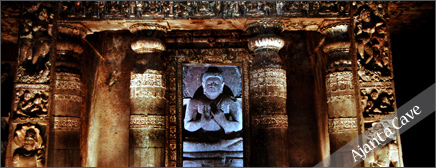 |
| A LEGACY FROM A GOLDEN AGE |
 |
|
| Ajanta and Ellora are the pride of Maharashtra. The
rock-cut caves of both these sites are world famous and illustrate the degree
of skill and artistry that Indian craftsmen had achieved several hundred years
ago. Ajanta dates from 100 B.C. while Ellora is younger by some 600 years. The
village of Ajanta is in the Sahyadri hills, about 99 kms. From Aurangabad; a
few miles away in a mammoth horseshoe-formed rock, are 30 caves overlooking a
gorge, `each forming a room in the hill and some with inner rooms. Al these
have been carved out of solid rock with little more than a hammer and chisel
and the faith and inspiration of Buddhism. Here, for the Buddhist monks, the
artisans excavated Chaityas (chapels) for prayer and Viharas (monasteries)
where they lived and taught. Many of the caves have the most exquisite detailed
carvings on the walls, pillars and entrances as well as magnificent wall
paintings. |
| These caves were discovered early in the 19th century quite by
chance by a party of British Officers on manoeuvres. Today the paintings and
sculptures on Buddha’s life, belonging to the more mellow and ritualistic
Mahayana Buddhism period, are world famous. Copies of them were shown in the
Crystal Palace exhibition in London in 1866. These were destroyed in a fire
there. Further copies were published soon afterwards and four volumes of
reproductions were brought out in 1933 by Ghulam Yazdani, the Director of
Archaeology of the then Hyderabad State. Ajanta has formed an epicentre of
interest for those who appreciate and are eager to know more about Indian
history and art. |
 |
It is a protected monument under the Archaeological Survey of
India and has been listed in the World Heritage list of monuments.The 30 caves of Ajanta were created over a span of some 600 years. |
|
| In their range of time and treatments they provide a panorama of life in
ancient India and are a source of all kinds of information... hair styles,
ornaments, textiles, musical instruments, details of architecture, customs etc.
It was from this collection of classical Indian art that a particular style was
formed that traveled with Buddhism to many parts of the world. Similar
paintings can be seen in Sigiriya in Sri Lanka, Bamiyan in Afghanistan, temples
and shrines in Tibet, Nepal, China and Japan. |
Royal patronage made Ajanta possible. Professional artists carried
out much of the work and each contributed his own individual skill and devotion
to this monumental work. |
| Visitors often ask how the artist who painted the detailed
frescoes and chiseled out the intricate carvings, managed to work in the dark
interiors of the caves. It has been noticed that the caves are illuminated by
natural light for part of the day and it is presumed that metal mirrors or
sheets of white cloth were used to reflect sunlight into the inner recesses. |
|
|
| Contd...2 |
|
|